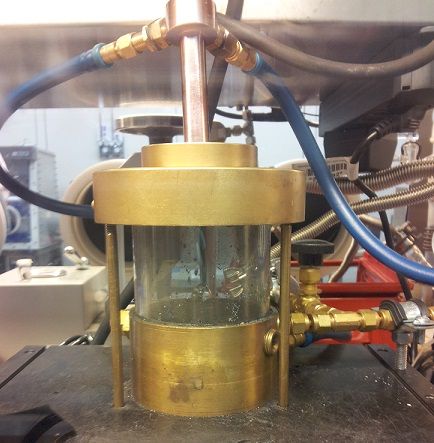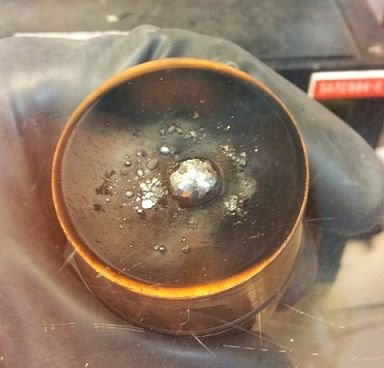#SciencePic: Melting metals in an arc
Hi Steemians,
with today's #sciencepic post, I will show you the second possibility to synthesize materials (e.g. intermetallic compounds) at high temperatures. I showed you the first option in a recent post: using metal ampoules.
Today, we have the second option: an arc melting furnace.

The function is in principle the same as in electro welding. In this case, the whole device is mounted in an argon filled glove box to guarantee oxygen free environment. You can see the blue tubes to cool the welding tip and bottom. This is necessary because the arc can easily reach 2000 °C - 3000 °C or more, depending on the current and voltage.
We use the welding process to close the above-mentioned niobium ampoules or in this case to let two substances react. For synthesizing e.g. CaSi (calcium silicide) you can take the pure elements silicon (here as a crushed silicon wafer) and calcium (small parts of an ingot), mixe them as good as possible and melt them together in the arc. After the reaction, the melting and cooling process is repeated to enhance the homogeneity. You can see in the next photo what the product looks like.

I hope, you liked the post. See you next time!
An electric arc furnace (EAF) is a furnace that heats charged material by means of an electric arc.
Industrial arc furnaces range in size from small units of approximately one ton capacity (used in foundries for producing cast iron products) up to about 400 ton units used for secondary steelmaking. Arc furnaces used in research laboratories and by dentists may have a capacity of only a few dozen grams. Industrial electric arc furnace temperatures can be up to 1,800 °C (3,272 °F), while laboratory units can exceed 3,000 °C (5,432 °F).
Arc furnaces differ from induction furnaces in that the charge material is directly exposed to an electric arc, and the current in the furnace terminals passes through the charged material.
Well, thank you for you contribution and addition on furnaces.
I just mentioned this topic to describe the pictures a little better. Maybe, I didn't use the correct terms because of translation issues...
By the way, an induction furnace was sometimes used to heat up directly the mentioned metal ampoules without putting them in silica ampoules, but I have no picture of this. :-)
Congratulations @thepe! You have completed some achievement on Steemit and have been rewarded with new badge(s) :
Click on any badge to view your own Board of Honor on SteemitBoard.
For more information about SteemitBoard, click here
If you no longer want to receive notifications, reply to this comment with the word
STOPCongratulations @thepe! You have completed some achievement on Steemit and have been rewarded with new badge(s) :
Click on any badge to view your own Board of Honor on SteemitBoard.
For more information about SteemitBoard, click here
If you no longer want to receive notifications, reply to this comment with the word
STOP